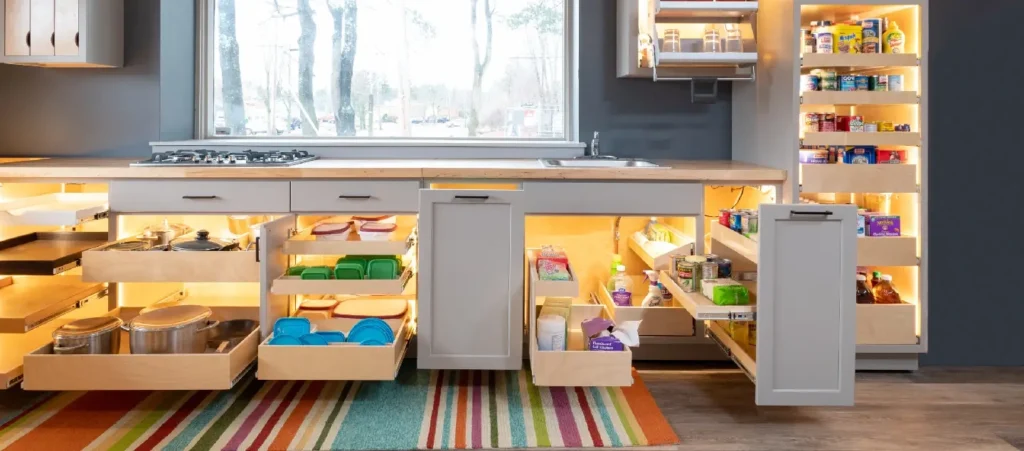A well-organized pantry makes cooking easier, saves time, and helps prevent food waste. Whether you have a small cabinet or a walk-in pantry, efficient storage and organization can transform your kitchen into a stress-free, functional space.
In this guide, we’ll cover expert tips and creative storage ideas to help you declutter, categorize, and maximize your pantry space.
1. Start with a Pantry Clean-Out 🗑
✔ Remove everything from your pantry.
✔ Check for expired items and discard them.
✔ Donate unopened, non-perishable items you won’t use.
✔ Wipe down shelves, bins, and jars for a fresh start.
💡 Pro Tip: Take note of ingredients you buy often so you can plan your storage accordingly.
2. Categorize Your Pantry Staples 📦
Group similar items together to make them easy to find.
Suggested Categories:
✔ Grains & Pasta – Rice, quinoa, pasta, oats
✔ Canned Goods – Soups, beans, vegetables, sauces
✔ Baking Supplies – Flour, sugar, baking soda, chocolate chips
✔ Snacks – Chips, crackers, granola bars, nuts
✔ Spices & Condiments – Seasonings, oils, vinegar, sauces
✔ Breakfast Items – Cereal, pancake mix, peanut butter
✔ Beverages – Coffee, tea, drink mixes
✔ Bulk & Extras – Large bags of food, extra supplies
💡 Pro Tip: Use clear bins and labels to keep categories easy to identify.
3. Invest in Storage Containers for a Clean Look 🏺
Ditch bulky packaging and transfer dry goods into airtight, stackable containers.
✔ Glass or Plastic Jars – Ideal for flour, sugar, rice, and pasta.
✔ Stackable Bins – Great for grouping snacks and small items.
✔ Lazy Susans – Perfect for condiments, oils, and sauces.
✔ Can Racks – Keep canned goods visible and accessible.
✔ Hanging or Over-the-Door Racks – Use for spices, small jars, or foil wraps.
💡 Pro Tip: Label everything! Use chalkboard labels or printed stickers for easy identification.
4. Use Vertical Space to Maximize Storage 📏
Even small pantries can hold more than you think when you use vertical space wisely.
✔ Install adjustable shelving to fit items of different heights.
✔ Use tiered risers for canned goods so nothing gets lost in the back.
✔ Hang hooks or baskets on the door for lightweight storage.
✔ Consider a rolling cart for flexible storage in tight spaces.
💡 Pro Tip: Store heavy items on lower shelves for easy access and safety.
5. Keep Frequently Used Items Within Reach 🙌
✔ Place everyday essentials like snacks and cereal at eye level.
✔ Store kids’ snacks on lower shelves for easy access.
✔ Reserve high shelves for rarely used items like holiday baking supplies.
💡 Pro Tip: Use clear bins for grab-and-go snacks to keep the pantry neat.
6. Rotate Your Stock to Reduce Waste ♻️
✔ Practice FIFO (First In, First Out) – Place new items in the back and older ones in the front.
✔ Keep an eye on expiration dates to avoid food spoilage.
✔ Use a chalkboard or whiteboard to track what needs replenishing.
💡 Pro Tip: Store soon-to-expire items in a “Use First” bin so they don’t go to waste.
7. Create a Snack Station for Quick Access 🍪
✔ Use a dedicated bin or basket for granola bars, chips, and fruit snacks.
✔ For healthy options, store nuts, dried fruit, and whole-grain crackers in portion-sized containers.
✔ If you have kids, create a kid-friendly snack bin within their reach.
💡 Pro Tip: Pre-portion snacks into small bags or containers to prevent over-eating and reduce mess.
8. Maintain Your Pantry with Weekly Check-Ins
✔ Do a quick 5-minute check-in every week to tidy up.
✔ Wipe down shelves and containers regularly.
✔ Restock essentials and remove any near-expired items.
💡 Pro Tip: Set a reminder on your phone for a monthly deep clean of your pantry.
Final Thoughts: A Tidy Pantry for a Stress-Free Kitchen
An organized pantry makes meal prep easier, saves money, and reduces waste. With these tips, you can create a functional, clutter-free space that works for your family.

